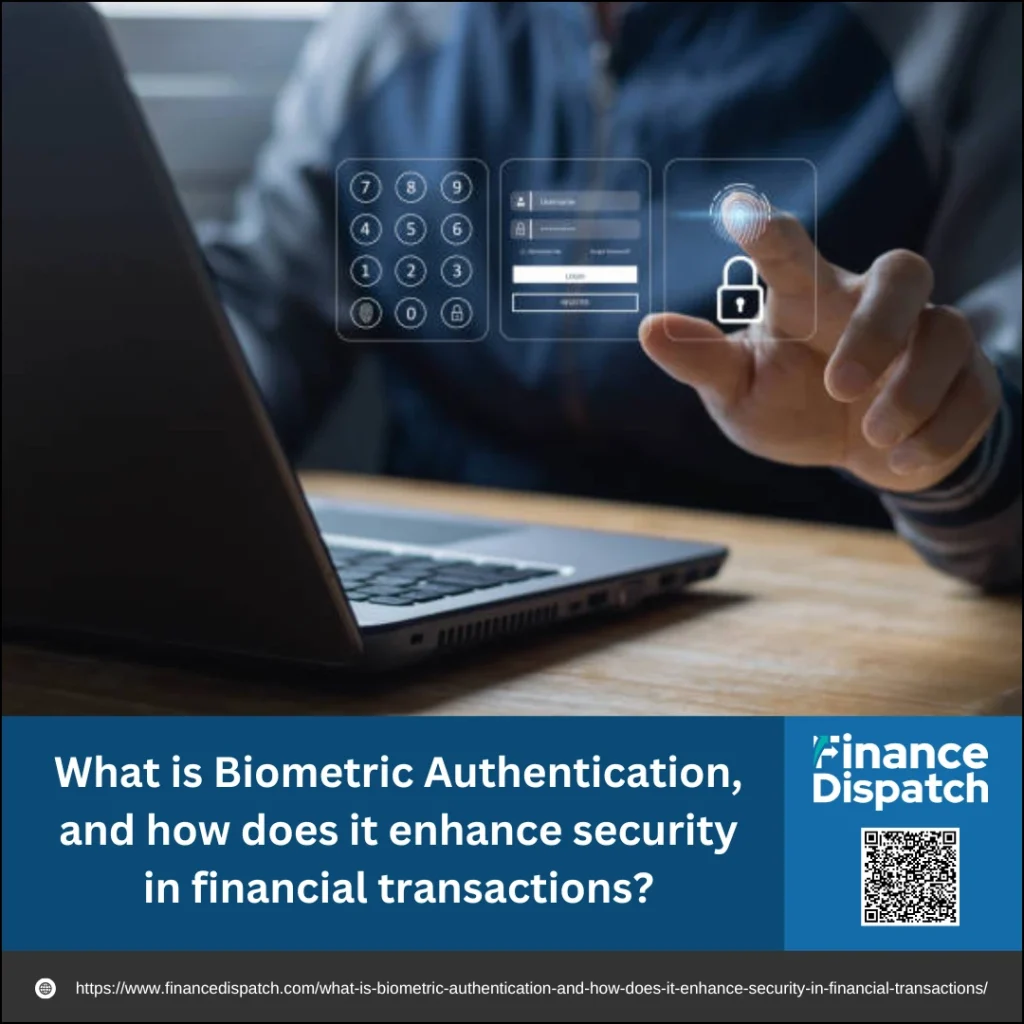In an era where digital transactions are rapidly replacing cash-based payments, security concerns are at an all-time high. Traditional authentication methods like passwords and PINs are increasingly vulnerable to hacking, phishing, and identity theft. As financial fraud continues to evolve, businesses and financial institutions are turning to biometric authentication—a cutting-edge security solution that uses unique biological traits such as fingerprints, facial recognition, and voice patterns to verify identities. Unlike passwords, which can be forgotten, stolen, or compromised, biometric authentication offers a more secure, convenient, and fraud-resistant way to safeguard financial transactions. By leveraging this technology, banks and payment providers can enhance user trust, reduce unauthorized access, and create a seamless banking experience for customers. In this article, we explore what biometric authentication is, its various types, and how it is revolutionizing security in financial transactions.
What is Biometric Authentication?
Biometric authentication is a security process that verifies a person’s identity based on unique biological or behavioral traits, such as fingerprints, facial recognition, iris scans, and voice patterns. Unlike traditional authentication methods that rely on passwords, PINs, or security tokens, biometric authentication is based on who you are rather than what you know or what you have. This technology works by capturing and analyzing a user’s biometric data and comparing it to stored templates in a secure database. If a match is found, access is granted. Widely used in smartphones, banking systems, and secure digital transactions, biometric authentication enhances security by making it significantly harder for fraudsters to replicate or steal someone’s identity. Its growing adoption in financial services reflects the increasing need for stronger, more reliable authentication methods that balance security and user convenience.
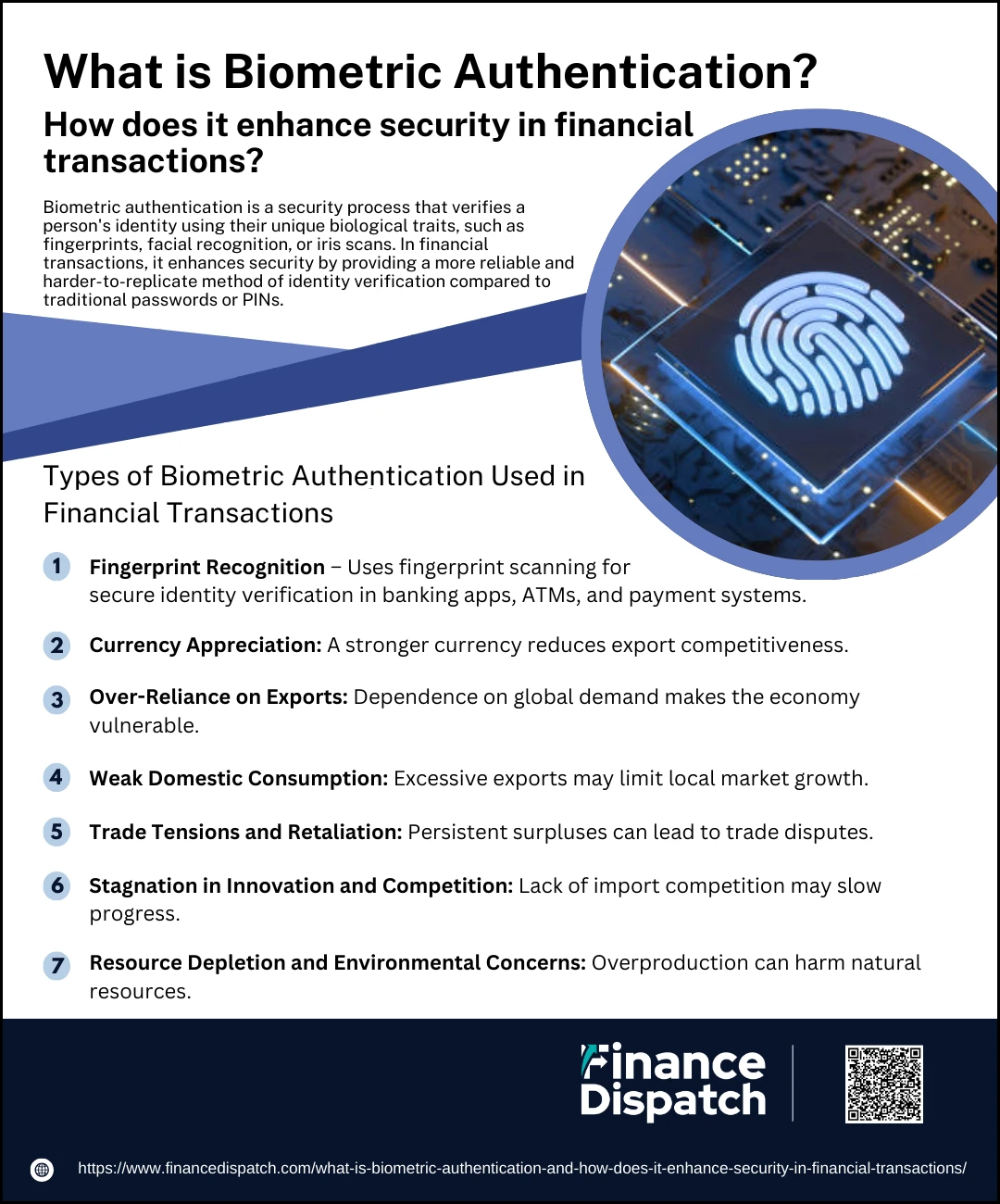 Types of Biometric Authentication Used in Financial Transactions
Types of Biometric Authentication Used in Financial Transactions
As digital financial transactions become the norm, ensuring secure and seamless authentication methods has never been more critical. Traditional security measures, such as passwords and PINs, are increasingly vulnerable to cyber threats like phishing, credential theft, and fraud. To counter these risks, financial institutions are integrating biometric authentication, which leverages unique biological traits to verify user identities. From fingerprint scanning to facial recognition, these methods provide a higher level of security and convenience. Below are the key types of biometric authentication used in financial transactions.
1. Fingerprint Recognition
One of the most widely used biometric authentication methods, fingerprint recognition scans and matches the ridges and patterns of a person’s fingerprint to verify identity. It is commonly used in mobile banking apps, biometric-enabled ATMs, and secure payment systems.
2. Facial Recognition
Facial recognition technology analyzes unique facial features, such as the distance between the eyes, nose, and mouth, to authenticate users. Many financial institutions integrate facial recognition into mobile banking apps and payment gateways to enhance security.
3. Iris and Retina Scanning
Iris and retina scans use high-resolution imaging to analyze unique patterns in the eye, providing one of the most accurate biometric authentication methods. While less common due to the need for specialized scanners, they are used in high-security financial environments.
4. Voice Recognition
Voice recognition technology authenticates users based on unique vocal patterns, pitch, and tone. It is frequently used in telephone banking services and customer support systems to verify identities without requiring passwords or security questions.
5. Palm and Hand Geometry Recognition
Palm recognition identifies users by scanning vein patterns in the palm, while hand geometry recognition analyzes the shape and size of a user’s hand. These methods are particularly useful in banking kiosks and high-value financial transactions requiring extra security layers.
6. Behavioral Biometrics
Unlike physical biometric traits, behavioral biometrics analyze how a user interacts with devices, including typing speed, mouse movements, and navigation habits. This method enhances fraud detection by identifying suspicious behavior patterns in online banking transactions.
7. Multimodal Biometric Authentication
This approach combines two or more biometric authentication methods for increased accuracy and security. For example, a financial institution may require both fingerprint and facial recognition for high-value transactions, ensuring a more robust authentication process.
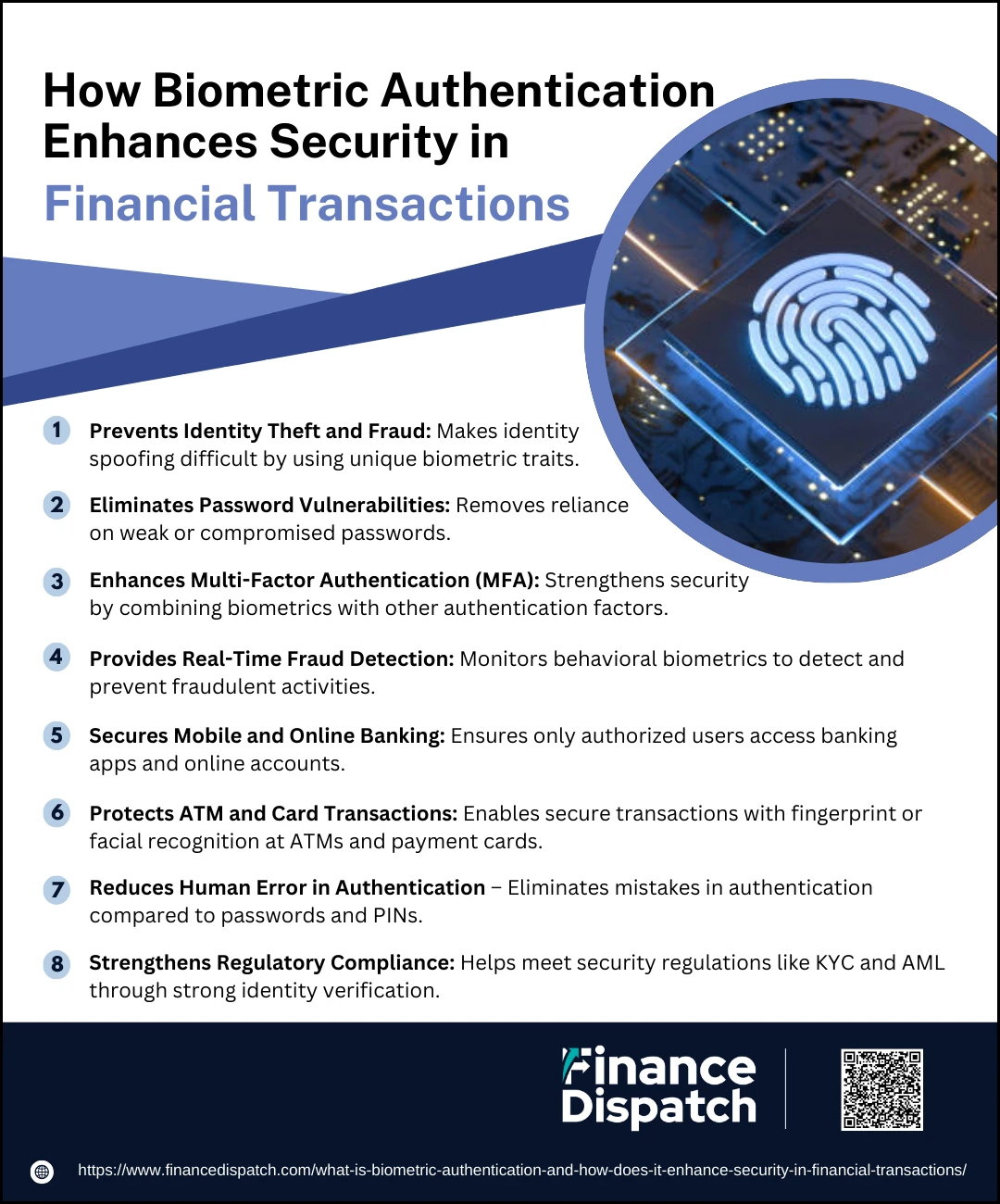 How Biometric Authentication Enhances Security in Financial Transactions
How Biometric Authentication Enhances Security in Financial Transactions
With the rapid increase in digital banking and online payments, securing financial transactions has become a top priority for businesses and consumers alike. Traditional authentication methods, such as passwords and PINs, are no longer sufficient to protect against sophisticated cyber threats like identity theft, phishing, and fraud. Biometric authentication offers a more secure and reliable alternative by using unique biological traits—such as fingerprints, facial recognition, and voice patterns—to verify a user’s identity. Unlike passwords, which can be stolen or guessed, biometric authentication provides an extra layer of security that is difficult to replicate. Below are the key ways biometric authentication enhances security in financial transactions.
1. Prevents Identity Theft and Fraud
Since biometric authentication relies on unique physical or behavioral traits, it significantly reduces the risk of stolen credentials being misused. Cybercriminals may hack passwords or PINs, but replicating someone’s fingerprint or iris scan is nearly impossible.
2. Eliminates Password Vulnerabilities
Passwords are often weak, reused, or shared, making them an easy target for hackers. Biometric authentication removes the need for passwords altogether, reducing the risk of brute-force attacks and credential stuffing.
3. Enhances Multi-Factor Authentication (MFA)
Financial institutions use biometric authentication as part of multi-factor authentication (MFA) to strengthen security. Combining biometrics with another factor—such as a one-time password (OTP) or security token—creates an extra security layer, making it much harder for attackers to gain unauthorized access.
4. Provides Real-Time Fraud Detection
Behavioral biometric authentication continuously monitors users’ actions, such as typing speed, swipe gestures, and voice modulation, to detect fraudulent behavior in real time. If an unusual activity is detected, the system can trigger additional security measures or block the transaction.
5. Secures Mobile and Online Banking
With the rise of mobile banking, biometric authentication ensures that only authorized users can access their accounts. Fingerprint and facial recognition technologies are widely used in banking apps, preventing unauthorized logins and unauthorized transactions.
6. Protects ATM and Card Transactions
Some ATMs now support biometric authentication, allowing users to withdraw cash using facial recognition or fingerprint scanning instead of a PIN. Similarly, biometric-enabled payment cards require a fingerprint match to authorize transactions, preventing card fraud.
7. Reduces Human Error in Authentication
Unlike passwords that users can forget or mistype, biometric authentication minimizes human errors in the authentication process. This ensures a seamless and secure transaction experience for users without compromising security.
8. Strengthens Regulatory Compliance
Financial institutions must comply with strict security regulations, such as Know Your Customer (KYC) and Anti-Money Laundering (AML) laws. Biometric authentication helps meet these requirements by ensuring strong identity verification, reducing fraudulent activities, and enhancing data protection.
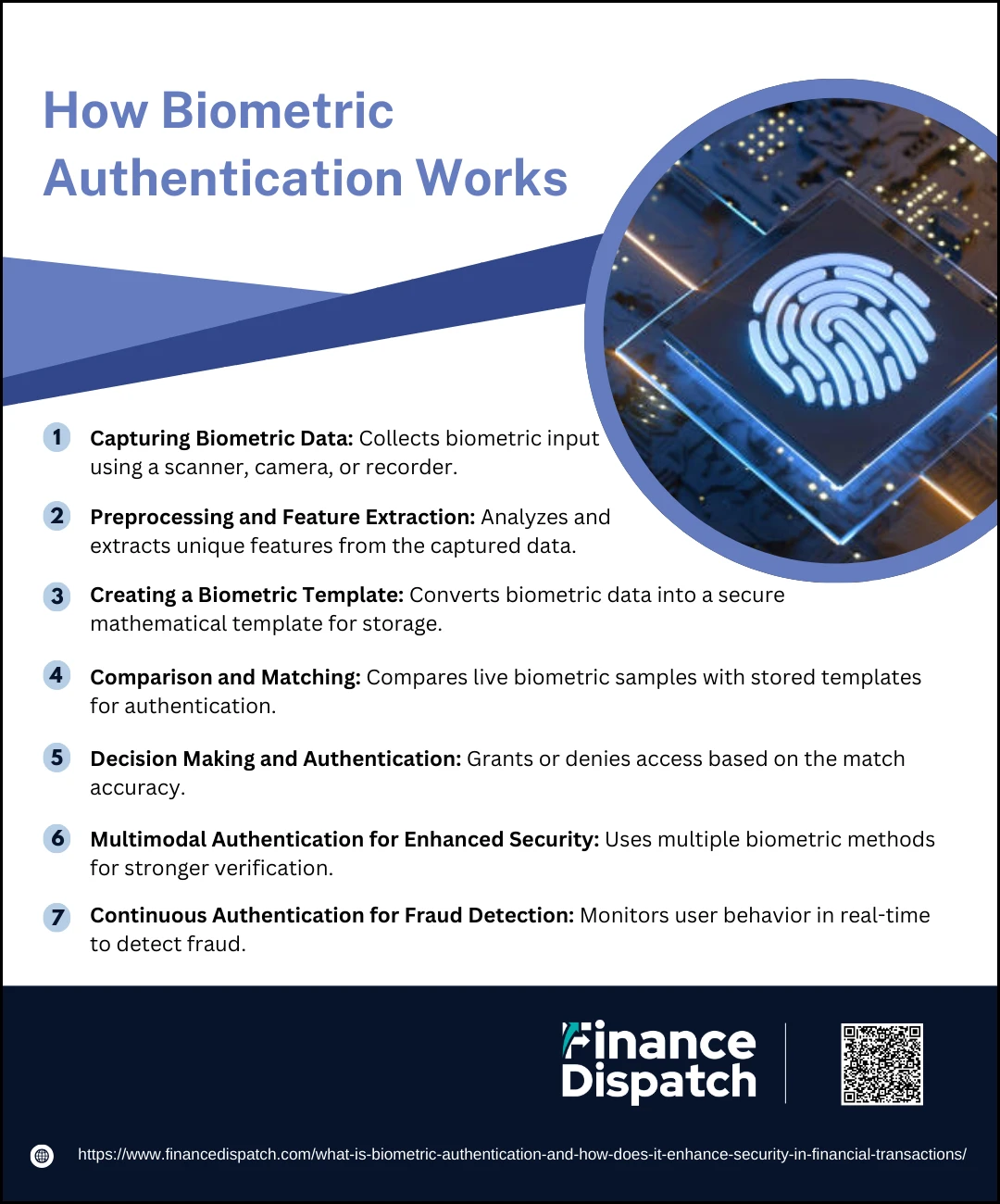 How Biometric Authentication Works?
How Biometric Authentication Works?
Biometric authentication is a cutting-edge security technology that verifies a person’s identity based on their unique biological or behavioral traits. Unlike traditional methods that rely on passwords or security tokens, biometric authentication uses fingerprints, facial recognition, voice patterns, and other characteristics that are nearly impossible to replicate. This ensures higher security, eliminates the risk of stolen credentials, and enhances user convenience. But how exactly does biometric authentication work? Below is a step-by-step breakdown of the process.
1. Capturing Biometric Data
The process begins by collecting a person’s biometric data through a specialized device, such as a fingerprint scanner, facial recognition camera, or voice recorder. This initial capture forms the reference template for future authentication.
2. Preprocessing and Feature Extraction
Once the biometric data is captured, the system processes it by extracting key features. For example, in facial recognition, the system maps out nodal points such as eye position, nose shape, and jawline structure to create a unique digital pattern.
3. Creating a Biometric Template
After extracting key features, the system converts the biometric data into a mathematical representation called a biometric template. This template is then securely stored in a database or encrypted for protection. Unlike raw biometric images, these templates cannot be reversed into original data, ensuring privacy.
4. Comparison and Matching
When a user attempts authentication, their live biometric sample is captured again and compared against the stored biometric template. The system uses complex algorithms to measure similarity and determine whether the sample matches the registered data.
5. Decision Making and Authentication
If the captured biometric data matches the stored template within an acceptable threshold, authentication is approved, granting access to the user. If the match fails, access is denied, and additional security checks may be triggered.
6. Multimodal Authentication for Enhanced Security
Some systems use multimodal biometric authentication, which combines multiple biometric factors—such as fingerprint and facial recognition—to enhance accuracy and prevent spoofing attempts. This adds an extra layer of security, particularly in high-risk financial transactions.
7. Continuous Authentication for Fraud Detection
In sensitive environments, continuous authentication is used, where the system constantly monitors user behavior, such as keystroke dynamics or navigation patterns, to detect anomalies and prevent unauthorized access.
Real-World Applications of Biometric Authentication in Finance
With the rise of digital banking and financial technology, biometric authentication has become a crucial tool for securing transactions and preventing fraud. By using unique biological traits such as fingerprints, facial recognition, and voice patterns, financial institutions can ensure only authorized users access sensitive accounts and services. This not only enhances security but also streamlines the customer experience. Below are some of the most impactful real-world applications of biometric authentication in finance.
- Banking and Mobile Payments: Biometric authentication is integrated into mobile banking apps and digital payment platforms, allowing users to securely log in and authorize transactions using fingerprints or facial recognition, eliminating the need for passwords or PINs.
- ATM Transactions: Some ATMs now support biometric authentication through fingerprint or facial recognition, reducing the risk of card skimming and PIN theft, making cash withdrawals more secure.
- Fraud Prevention and Risk Management: Banks use behavioral biometrics, such as typing speed and navigation patterns, to detect fraudulent activities in real-time and prevent unauthorized transactions.
- Customer Identity Verification (KYC Compliance): Financial institutions leverage biometric authentication to comply with Know Your Customer (KYC) and Anti-Money Laundering (AML) regulations, ensuring that only verified individuals can open or manage accounts.
- Call Center Authentication: Voice recognition technology enables secure and seamless customer verification in call centers, reducing the risk of fraud and impersonation in telephone banking.
- Cryptocurrency and Digital Wallets: Biometric authentication secures access to crypto wallets and DeFi platforms, ensuring that only authorized users can perform trades or withdrawals, enhancing digital asset security.
- High-Value Financial Transactions: For large transactions, banks implement biometric-based multi-factor authentication (MFA) to prevent unauthorized fund transfers and enhance transaction security.
- Access Control in Financial Institutions: Banks and financial organizations use biometrics to restrict access to sensitive areas, such as vaults and server rooms, ensuring that only authorized personnel can enter.
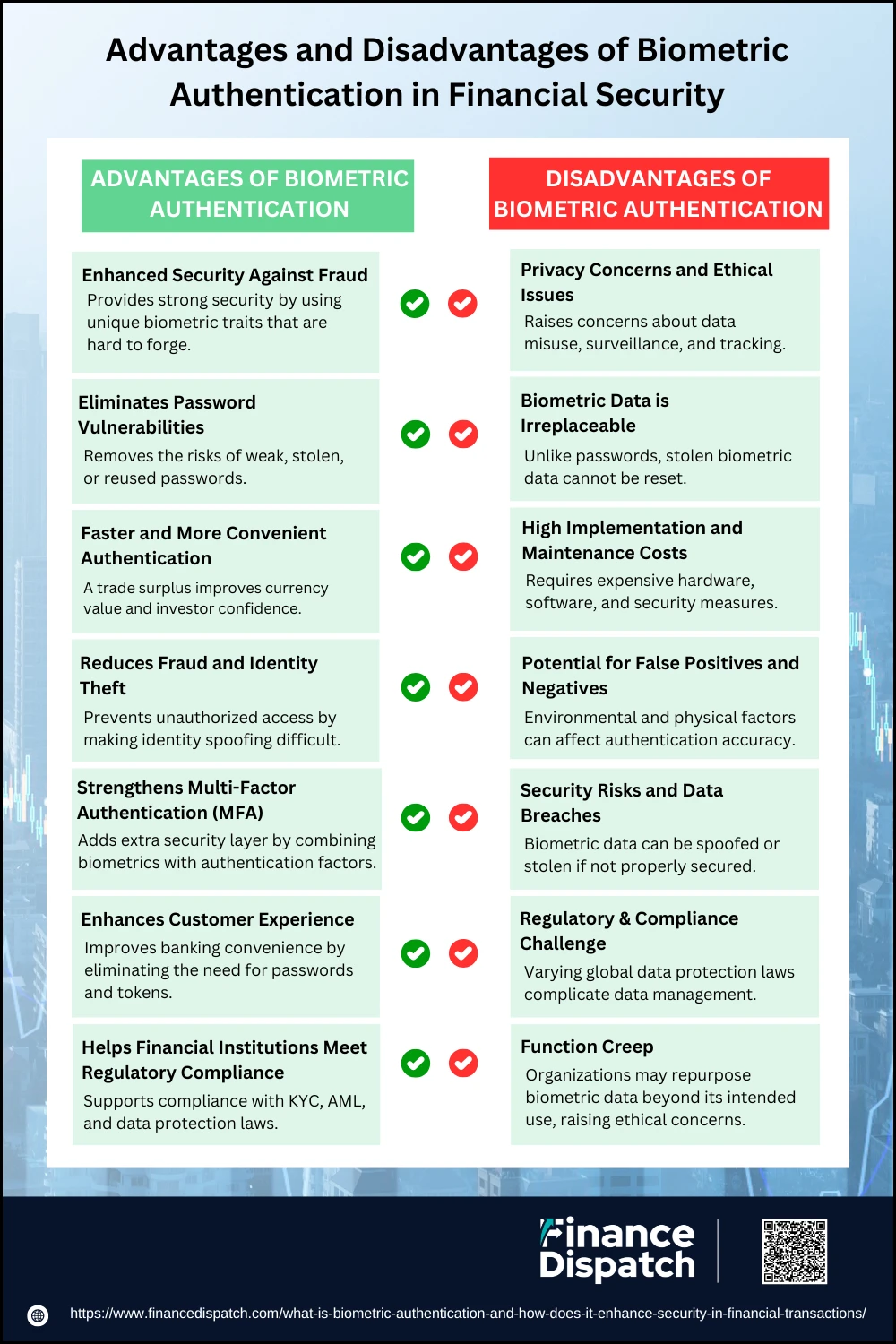 Advantages and Disadvantages of Biometric Authentication in Financial Security
Advantages and Disadvantages of Biometric Authentication in Financial Security
As financial transactions move increasingly online, ensuring security without compromising convenience has become a top priority. Biometric authentication offers a sophisticated solution by using unique biological traits—such as fingerprints, facial recognition, and voice patterns—to verify identities. This technology enhances security, prevents fraud, and simplifies user authentication. However, like any security measure, biometric authentication has both advantages and disadvantages in financial security. Below is a closer look at its pros and cons.
Advantages of Biometric Authentication in Financial Security
1. Enhanced Security Against Fraud
Biometric authentication provides a stronger level of security than traditional methods like passwords or PINs. Since each individual’s biometric data is unique, it is nearly impossible for cybercriminals to replicate, steal, or forge a user’s identity, significantly reducing financial fraud, identity theft, and account takeovers.
2. Eliminates Password Vulnerabilities
One of the biggest flaws of traditional authentication is the reliance on passwords, which users often reuse, forget, or make weak. Biometrics remove this vulnerability, ensuring that unauthorized access through stolen credentials is far less likely. No more phishing scams, brute force attacks, or credential stuffing!
3. Faster and More Convenient Authentication
Biometric authentication allows users to log in or authorize financial transactions in seconds with a fingerprint scan, facial recognition, or voice command. Unlike passwords or OTPs (one-time passwords), which require manual entry and are prone to errors, biometric authentication is instant and effortless.
4. Reduces Fraud and Identity Theft
Financial institutions can better detect and prevent fraudulent activities using biometric authentication. Criminals cannot easily forge biometric identifiers like fingerprint or iris scans, ensuring only the rightful account holder gains access to financial services.
5. Strengthens Multi-Factor Authentication (MFA)
Many financial institutions are implementing biometric authentication as part of MFA, where it is combined with other security measures such as passwords, OTPs, or mobile device verification. This multi-layered security significantly reduces unauthorized access risks.
6. Enhances Customer Experience
A seamless and frictionless user experience is crucial for banking and online transactions. Biometric authentication allows customers to securely access financial services without memorizing passwords or carrying authentication tokens, leading to higher customer satisfaction.
7. Helps Financial Institutions Meet Regulatory Compliance
Biometric authentication supports compliance with global financial security regulations such as:
- Know Your Customer (KYC) – ensuring the legitimacy of customers before they access services.
- Anti-Money Laundering (AML) – preventing fraudulent financial activities.
- General Data Protection Regulation (GDPR) – ensuring proper handling and security of biometric data.
Disadvantages of Biometric Authentication in Financial Security
1. Privacy Concerns and Ethical Issues
Biometric data is highly personal and sensitive. Many users worry about how financial institutions collect, store, and use their biometric information. Unauthorized surveillance, data misuse, and unethical tracking are growing concerns in today’s digital world.
2. Biometric Data is Irreplaceable
Unlike passwords that can be changed, biometric data is permanent. If a hacker breaches a financial institution’s database and steals biometric templates, the affected users cannot simply reset their fingerprint or retina scan. Once compromised, their security is permanently at risk.
3. High Implementation and Maintenance Costs
Setting up biometric authentication requires specialized hardware and software, such as fingerprint scanners, high-resolution cameras, and AI-driven fraud detection systems. Financial institutions must invest heavily in both infrastructure and security protocols to ensure biometric data is protected.
4. Potential for False Positives and Negatives
Biometric authentication is not 100% foolproof. Factors such as poor lighting, wet or dirty fingerprints, injuries, or aging can affect accuracy. Some users may experience false rejections (legitimate users being denied access) or false acceptances (unauthorized users gaining access).
5. Security Risks and Data Breaches
Although biometric authentication reduces fraud, it is not immune to cyberattacks. Hackers have developed techniques to spoof biometric data using deepfake technology, high-resolution photos, or fake fingerprints. Additionally, financial institutions storing biometric data must have robust encryption to prevent breaches.
6. Regulatory and Compliance Challenges
Different countries have varying data protection laws, making it complex for international banks and financial institutions to legally store and process biometric data across multiple jurisdictions. Non-compliance can result in legal penalties and reputational damage.
7. Function Creep – The Risk of Misuse
Once biometric authentication is implemented, organizations may expand its use beyond its original purpose without users’ consent. This function creep raises concerns about mass surveillance, unauthorized data tracking, and government misuse of biometric information.
Challenges and Risks of Biometric Authentication
Biometric authentication provides high security and convenience, but it also comes with significant risks and challenges. From privacy concerns to security threats, financial institutions and businesses must address these issues to ensure safe biometric implementation. Below are the key risks associated with biometric authentication.
- Privacy Concerns: Biometric data is highly sensitive and permanent. If compromised, users cannot reset their fingerprints or facial data, raising concerns about unauthorized tracking and data misuse.
- Security Risks and Data Breaches: Hackers target biometric databases because stolen biometric data cannot be changed. Advanced spoofing techniques, such as deepfakes and fake fingerprints, pose security threats.
- False Acceptance and Rejection Rates: Biometric systems can produce false positives (unauthorized access) or false negatives (denying legitimate users), leading to security flaws and usability issues.
- High Implementation and Maintenance Costs: Biometric authentication requires expensive hardware, software, and continuous updates, making it costly for businesses to implement and maintain.
- Ethical and Legal Challenges: Strict data protection laws (e.g., GDPR, CCPA) regulate biometric use. Function creep—using biometric data beyond its original purpose—raises concerns about mass surveillance and ethical misuse.
- Limited Accessibility: Some people, such as elderly users, individuals with disabilities, or those without smartphones, may face difficulties in using biometric authentication systems.
- Risk of Government and Corporate Misuse: Biometric data can be misused for mass surveillance, tracking, and restricting freedoms, raising concerns about civil liberties and consumer rights.
Future of Biometric Authentication in Financial Security
As cyber threats continue to evolve, the future of biometric authentication in financial security is set to become more advanced, secure, and widely adopted. Financial institutions are increasingly integrating AI-driven biometric systems, enhancing fraud detection and real-time authentication. Emerging technologies such as multimodal biometrics—which combine fingerprints, facial recognition, and voice authentication—will offer greater accuracy and security. Additionally, blockchain technology is expected to play a crucial role in securing biometric data by decentralizing storage, reducing risks of data breaches. With the rise of continuous authentication, financial platforms will analyze user behavior patterns over time to detect anomalies and prevent fraud. Furthermore, wearable biometric devices and biometric payment cards will make transactions more seamless and secure. However, the future of biometric authentication must also address privacy concerns and regulatory challenges to ensure ethical and responsible use. As financial security advances, biometric authentication will remain a cornerstone of digital banking, offering both enhanced security and user convenience.
Conclusion
Biometric authentication is revolutionizing financial security by providing a faster, more secure, and user-friendly alternative to traditional authentication methods. With its ability to prevent fraud, eliminate password vulnerabilities, and enhance multi-factor authentication, biometric technology has become an essential tool in digital banking and financial transactions. However, challenges such as privacy concerns, data security risks, and regulatory compliance must be addressed to ensure ethical and secure implementation. As advancements in AI, blockchain, and multimodal biometrics continue to shape the future, biometric authentication will remain a key driver of financial security, balancing strong protection with seamless user experiences. Financial institutions must continue to invest in secure, privacy-focused solutions to maintain trust and security in an increasingly digital world.



